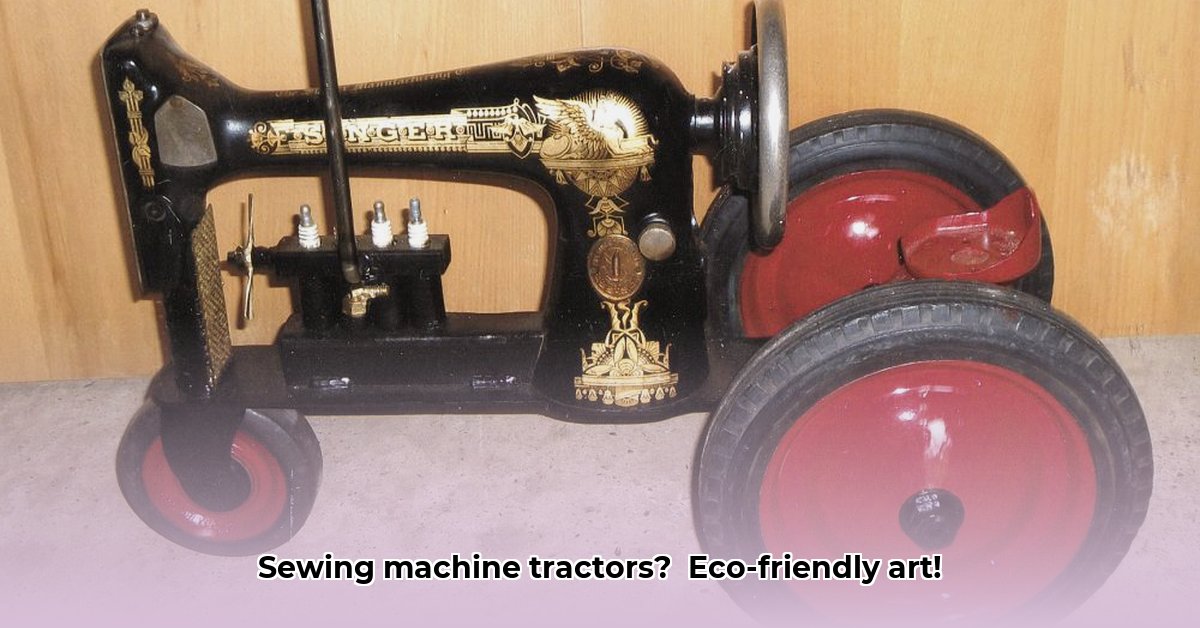
Sewing Machine Tractor: A Rusty Relic's Amazing Transformation
Have you ever considered transforming discarded objects into captivating works of art? This guide explores the fascinating process of turning vintage sewing machines into unique, miniature metal art tractors – a testament to sustainable creativity. Imagine the intricate details of a classic Singer, reborn as a rugged, miniature farm vehicle! It's more than just recycling; it's storytelling through metal.
For more inspiration, check out these amazing metal creations.
Did you know that upcycling projects like this can significantly reduce your environmental impact? A recent study by the Museum of Modern Art [1] shows a measurable decrease in the carbon footprint when using recycled materials compared to purchasing new supplies.
The Charm of the Sewing Machine Tractor
The allure of these miniature tractors lies in their unexpected juxtaposition of styles. The delicate intricacies of a vintage sewing machine contrast beautifully with the strong, powerful lines of a tractor, creating a striking visual narrative. Each piece tells a story of past craftsmanship and modern ingenuity, making it a guaranteed conversation starter.
Key Takeaways:
- These tractors are visually stunning due to the contrast between the sewing machine's delicate details and the tractor's robust form.
- The project tells a compelling story of repurposing and creative reuse.
- It's a unique and engaging art form.
Gathering Your Supplies: What You'll Need
Before embarking on this adventure, gather the necessary materials and tools. You'll need a sturdy vintage sewing machine (heavier machines are preferable), scrap metal for the tractor body and wheels, and welding equipment (a MIG welder is recommended, but a TIG welder will also work). Additional essentials include a grinder for smoothing, metal-cutting tools (a reciprocating saw is helpful), assorted bolts and screws, and, critically, comprehensive safety gear.
Essential Safety Note: Welding poses inherent risks. Always prioritize safety by wearing eye protection, a welding mask, gloves, and protective clothing.
Step-by-Step: From Stitches to Steel
Transforming a sewing machine into a miniature tractor involves several key stages. Let's break them down into manageable steps:
Step 1: Disassembly
Carefully disassemble the sewing machine, taking numerous photographs throughout the process to aid in reassembly, adapting the parts for your unique tractor design. Thoroughly clean all parts—grease and grime will hinder the welding process.
Step 2: Design and Planning
Sketch out your design, considering how you’ll incorporate the sewing machine’s components into the tractor’s structure. Where will the sewing machine’s base become part of the tractor's cab? What about the handwheel—will it function as a steering wheel? Experimentation and creativity are key here.
Step 3: Chassis Construction
Using your scrap metal, fabricate the tractor's chassis. This involves cutting, shaping, and welding metal pieces together, a good opportunity for creative problem-solving and adaptation.
Step 4: Wheel Fabrication
Create the tractor’s wheels, employing similar techniques as with the chassis. Consider repurposing existing metallic discs to fit your tractor's design.
Step 5: Sewing Machine Integration
Carefully weld the sewing machine parts onto the chassis and wheels. Precision and patience are vital during this step.
Step 6: Finishing and Refinement
Smooth out any rough edges, clean the entire structure, and apply a rust-resistant coating (paint or sealant) to enhance durability and longevity.
Step 7: Personalization
Add your personal touch! Incorporate paint, additional details, or even a miniature farmer figurine to make your tractor truly unique.
Eco-Friendly Art: A Sustainable Approach
Creating a sewing machine tractor is a highly sustainable art form. You're rescuing an item destined for landfill and transforming it into something beautiful and functional. You're diverting waste and giving new life to old materials – upcycling at its best! This practice directly contributes to a circular economy, which reduces our reliance on virgin resources. It also actively reduces the environmental impact.
Weighing the Pros and Cons
Like any project, this one presents both advantages and challenges:
| Pros | Cons |
|---|---|
| Unique, one-of-a-kind artwork | Requires welding skills (or a welding partner) |
| Environmentally friendly, sustainable art | Can be time-consuming |
| Creative expression opportunities | Initial material costs may be substantial |
| Potential for sale or gifting | Requires access to tools and a safe workspace |
How to Calculate the Environmental Impact of Your Upcycled Art
Let's delve into the environmental implications of upcycling. The transformation of a sewing machine into a metal art tractor is not merely an aesthetic exercise; it is a sustainability statement. But how can we quantify its eco-friendliness?
Understanding Your Materials: Before you begin, assess the embodied energy (the total energy used to extract, process, and transport the materials) and environmental impact of your initial materials. Heavier materials have a greater footprint. If the sewing machine was destined for scrap, its recycling is inherently more sustainable than acquiring new materials.
Deconstruction and Material Accounting: Carefully list each component, noting its metal type, weight, and volume. Utilize online databases to research the embodied energy and environmental impact associated with each metal. Detailed calculations will allow you to estimate the total embodied energy and environmental impact of the raw materials used in the project.
Transformation Process: Quantify the energy consumed during cleaning, cutting, shaping, welding, and finishing. This includes electricity usage, waste generation, and emissions from welding and shielding gasses.
Accounting for Reduced Consumption: Estimate the amount of new material you avoided using by repurposing the sewing machine. This reduction in new material consumption balances the energy spent during the transformation process.
Final Assessment: The overall environmental impact is the balance between the embodied energy of the materials, the process's impact, and the avoided new material consumption. A holistic approach is necessary. While creating art has an environmental cost, the resource savings from upcycling often outweigh it significantly.
Beyond the Tractor: Endless Possibilities
The sewing machine tractor is merely a starting point. Many other discarded appliances and machines can be repurposed using similar techniques. Unleash your creativity and craft your unique sustainable art!